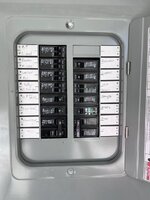I’m tossing around the idea of an EV for commuter duty. In the garage I’d most likely use, there’s a sub panel 5 feet from where I’d park. The 30 amp compressor circuit goes to an outlet in the basement for a future compressor that I likely won’t ever need. Am I correct that I could just have a 30 amp outlet right next to this sub panel and disconnect the wiring to my downstairs compressor circuit?
I believe this sub panel is limited to 125 amps according to the sticker on the door and has a 100 amp breaker on the panel that feeds it. I’d like 40 or 50 amps for an EV charger but in actuality that isn’t necessary for my current situation.

I believe this sub panel is limited to 125 amps according to the sticker on the door and has a 100 amp breaker on the panel that feeds it. I’d like 40 or 50 amps for an EV charger but in actuality that isn’t necessary for my current situation.



